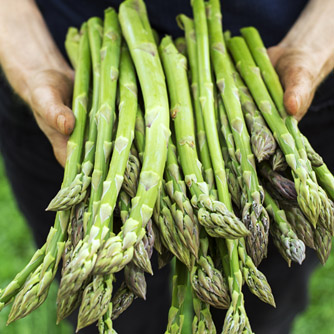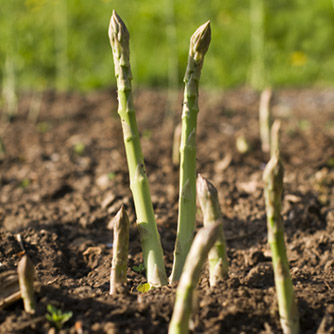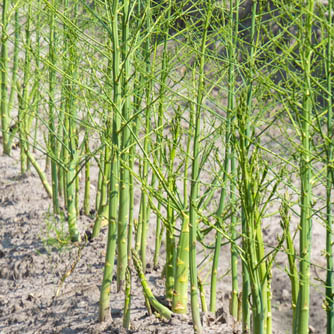Asparagus
BackAsparagus is one of the most well known spring vegetables and the arrival of fresh spears from beneath the ground, as if by magic, is one of the true joys of vegetable gardening.
Once established, asparagus is an easy and rewarding crop to grow in your vegetable garden. Freshly picked spears are crisp and so full of flavour you’ll never want to eat store bought spears again!
How to Grow Asparagus
Asparagus is a herbaceous perennial which means it dies down completely over winter leaving the underground crown dormant. In spring new growth appears which are the tasty spears we love to eat. Mostly spears are harvested in spring and early summer but after that the shoots are left to grow into long ferny fronds up to 1.5m tall. These fronds are producing energy that helps to recharge the underground crown. In autumn the fronds will start to brown off. By winter they’ll be fully dead and need to be cut off at ground level.
Asparagus is normally grown from crowns which are purchased bare rooted in winter but it can also be grown from seed. Starting with crowns is a faster way to getting tasty spears but you will still need to wait 1-2 years before harvesting any. Instead let all spears grow into fronds to allow the crown to fully establish and develop a strong root system in preparation for all the springs to follow. Once planted asparagus crowns can survive for 20 years or more, so they are a worthwhile, long term investment.

Freshly harvested asparagus spears
Choose a sunny position for your asparagus bed where the soil is free draining and has been prepped with plenty of organic matter like compost and manures. If you’ve got a heavy clay soil work in some gypsum as well and make sure the crowns are planted up on raised mounds. Asparagus likes a slightly acidic soil with a pH around 6.5-7. If your soil is alkaline (above 7) then apply sulfur, if you soil pH is too acidic (less than 6.5) apply some lime or dolomite.
Plant dormant crowns in holes 15-20cm deep and approximately 30cm wide. This will allow enough space to fully spread out the roots of the crown. Cover with 5cm of soil and water in with OCP eco-seaweed to encourage strong healthy root growth.
When the growth emerges in spring let it grow 5cm then backfill the hole with another 5cm of soil. Repeat until the soil is level with the top of the trench and then mulch over the top. During this process water the crowns every 2 weeks with OCP eco-aminogro and OCP eco-seaweed to establish healthy plants.
Asparagus in Tropical and Subtropical Climates
Plants will happily grow in these warmer climates but often the spears are smaller in size. Luckily they are still just as tasty! Heavy summer rains means subtropical gardeners can usually get a second harvest window later on if plants are vigorous and healthy.
In tropical areas harvesting is usually done late autumn and into winter. Note that the foliage won’t die down in tropical regions.

Emerging asparagus spears
Sowing Guide for Asparagus
Sow asparagus seed in punnets indoors during winter and place somewhere warm. Be patient as seeds can take 3 weeks to germinate and the seedlings are slow growing. Give them weekly doses of OPC eco-aminogro and OCP eco-seaweed to help speed things up.
When large enough to plant out, first put the punnets in a sheltered spot outside for a week to acclimatise. Then plant the seedlings into your garden bed. From seed it will take 3 years before you can harvest asparagus spears.
Fertilising & Maintenance of Asparagus
Asparagus should be kept well fed and watered to maximise the growth of the crown and the number of spears it will produce. Apply compost and well rotted manure to the surface above dormant crowns in late winter or early spring. Then when plants are actively growing give fortnightly applications of OCP eco-aminogro and OCP eco-seaweed to keep them pumping along.
Regularly top up the mulch to help keep asparagus beds weed free. Weeds will compete with the crown for moisture and nutrients and reduce your harvest. If weeds become a problem hand weed them out or carefully spray with Slasher (avoid hitting any growing spears).
Remember asparagus prefers a soil pH of 6.5-7.0, so test your soil at least once a year and, if necessary, apply lime or dolomite to raises the soil pH or sulfur to lower it.
Always cut back the dead fronds each winter to keep things tidy and reduce the chance of diseases. It’ll also help you spot when spears start appearing in spring.
Note that asparagus grows as separate male and female plants. If you have multiple plants then you may get seeds develop on the fronds resulting in seedlings popping up later on. These should be removed as they’ll only compete with your established crowns for water and nutrients.

Bare rooted asparagus crowns
Harvesting Asparagus
Firstly, resist the urge to harvest from new crowns until they are in their second year in the ground or third year if grown from seed. Harvesting too early will challenge the long term health of your plant so wait until spears are thicker than a pencil.
Ideally harvest asparagus spears in the morning, when they are fresh, using a sharp knife to cut them off just below ground level. Never pull them out because you can damage the crown. Once your asparagus bed gets growing you’ll find you need to check it almost daily for new spears. If left to grow too long spears toughen and aren’t very nice to eat.
By the way if you want white asparagus all you need to do is grow it in the dark! Commercial growers put darkened tunnels over their rows and the lack of sunlight stops the emerging spears turning green - effectively blanching them white. You can try this yourself by covering the area where spears will shoot from with a dark coloured plastic tub or a wire frame covered in dark fabric. Check on the spears daily. They should be ready to harvest 2-3 days after emerging from the ground.
Pests and Diseases of Asparagus
For many people asparagus is an easy to grow, trouble free plant. However there are a few things to watch out for:
- Snails & slugs – newly emerging spears can be attacked by these hungry guys. Protect by scattering OCP eco-shield pellets around the beds.
- Crown rot – in poorly draining soils the crown can be destroyed by several different fungi. Ideally asparagus should always be planted in free draining soils. If in doubt improve drainage with organic matter and gypsum (in clay soils). Try planting in raised up mounds.
- Foliage and stem diseases – there are several different diseases, like rust, which can cause leaf damage, defoliation and early stem dieback. To reduce these issues there are several basic steps to follow: Plant in a position that will receive good airflow (especially in humid climates). Always remove all dead foliage and stems. Keep plants well water during hot dry periods but avoid wetting the foliage. Ensure plants are well fed and also given regular applications of OPC eco-seaweed will help keep stress levels down. If necessary apply an organic fungicide.
Asparagus Varieties
Asparagus ‘Mary Washington’ – this is a traditionally grown variety which produces a good crop of slender green spears.
Asparagus ‘Fat Bastard’ - with a name like this it’s hardly surprising that the spears are fat and tasty! A great tasting asparagus and the plants have shown to be rust resistant.
Asparagus ‘Sweet Purple’ - not all asparagus is green! This purple beauty is, as the name suggests, very sweet - up to 20% sweeter than green asparagus.

Asparagus spears left to grow into fronds to recharge the crowns


